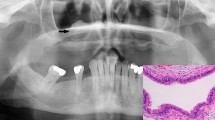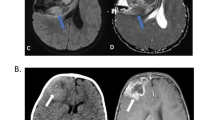Abstract
Central nervous system primitive neuroectodermal tumors (CNS-PNET) and pineoblastomas (PBL) are rare in adulthood. Knowledge on clinical outcome and the efficacy and toxicities of chemotherapy in addition to radiotherapy is limited. Patients older than 21 years at diagnosis were followed in the observational arm of the prospective pediatric multicenter trial HIT 2000. After surgery, craniospinal irradiation and maintenance or sandwich chemotherapy were recommended. Radiotherapy was normo- (35.2 Gy; tumor region, 55.0 Gy; metastasis, 49.6 Gy) or hyperfractionated (40.0 Gy; tumor bed, 68.0 Gy; metastasis, 50–60 Gy). Maintenance chemotherapy consisted of eight courses (vincristine, lomustine, cisplatin). Sandwich chemotherapy included two cycles of postoperative chemotherapy followed by radiotherapy, and four courses of maintenance chemotherapy. Seventeen patients (CNS-PNET, n = 7; PBL, n = 10), median age 30 years, were included. Eight patients had a postoperative residual tumor and four patients metastatic disease. The median follow-up of ten surviving patients was 41 months. The estimated rates for 3-year progression-free survival (PFS) and overall survival were 68 ± 12 and 66 ± 13 %, respectively. PBL compared to CNS-PNET tended towards a better PFS, although the difference was not clear (p = 0.101). Both chemotherapeutic (maintenance, n = 6; sandwich, n = 8) protocols did not differ in their PFS and were feasible with acceptable toxicities. Intensified regimens of combined chemo- and radiotherapy are generally feasible in adults with CNS-PNET/PBL. The impact of intensified chemotherapy on survival should be further assessed.



Similar content being viewed by others
References
Picard D, Miller S, Hawkins CE, Bouffet E, Rogers HA, Chan TS, Kim SK, Ra YS, Fangusaro J, Korshunov A, Toledano H, Nakamura H, Hayden JT, Chan J, Lafay-Cousin L, Hu P, Fan X, Muraszko KM, Pomeroy SL, Lau CC, Ng HK, Jones C, Van Meter T, Clifford SC, Eberhart C, Gajjar A, Pfister SM, Grundy RG, Huang A (2012) Markers of survival and metastatic potential in childhood CNS primitive neuro-ectodermal brain tumours: an integrative genomic analysis. Lancet Oncol 13(8):838–848
Gessi M, Setty P, Bisceglia M, zur Muehlen A, Lauriola L, Waha A, Giangaspero F, Pietsch T (2011) Supratentorial primitive neuroectodermal tumors of the central nervous system in adults: molecular and histopathologic analysis of 12 cases. Am J Surg Pathol 35(4):573–582
Hayden JT, Fruhwald MC, Hasselblatt M, Ellison DW, Bailey S, Clifford SC (2009) Frequent IDH1 mutations in supratentorial primitive neuroectodermal tumors (sPNET) of adults but not children. Cell Cycle 8(11):1806–1807
Biswas S, Burke A, Cherian S, Williams D, Nicholson J, Horan G, Jefferies S, Williams M, Earl HM, Burnet NG, Hatcher H (2009) Non-pineal supratentorial primitive neuro-ectodermal tumors (sPNET) in teenagers and young adults: time to reconsider cisplatin based chemotherapy after cranio-spinal irradiation? Pediatr Blood Cancer 52(7):796–803
Boiardi A, Silvani A, Eoli M, Fariselli L, Zappacosta B, Salmaggi A (2000) Embryonal tumors in the adult population: implications in therapeutic planning. Neurol Sci 21(1):23–30
Chang SM, Lillis-Hearne PK, Larson DA, Wara WM, Bollen AW, Prados MD (1995) Pineoblastoma in adults. Neurosurgery 37(3):383–390 discussion 390–381
Herrlinger U, Steinbrecher A, Rieger J, Hau P, Kortmann RD, Meyermann R, Schabet M, Bamberg M, Dichgans J, Bogdahn U, Weller M (2005) Adult medulloblastoma: prognostic factors and response to therapy at diagnosis and at relapse. J Neurol 252(3):291–299
Kim DG, Lee DY, Paek SH, Chi JG, Choe G, Jung HW (2002) Supratentorial primitive neuroectodermal tumors in adults. J Neurooncol 60(1):43–52
Lutterbach J, Fauchon F, Schild SE, Chang SM, Pagenstecher A, Volk B, Ostertag C, Momm F, Jouvet A (2002) Malignant pineal parenchymal tumors in adult patients: patterns of care and prognostic factors. Neurosurgery 51(1):44–55 discussion 55–46
Ohba S, Yoshida K, Hirose Y, Ikeda E, Kawase T (2008) A supratentorial primitive neuroectodermal tumor in an adult: a case report and review of the literature. J Neurooncol 86(2):217–224
Tate M, Sughrue ME, Rutkowski MJ, Kane AJ, Aranda D, McClinton L, McClinton L, Barani IJ, Parsa AT (2012) The long-term postsurgical prognosis of patients with pineoblastoma. Cancer 118(1):173–179
Gerber NU, von Hoff K, Friedrich C, von Bueren AO, Treulieb W, Benesch M, Faldum A, Pietsch T, Warmuth-Metz M, Rutkowski S, Kortmann R (2012) Hyperfractionated craniospinal radiochemotherapy followed by maintenance chemotherapy in children older than 4 years with supratentorial central nervous system primitive neuroectodermal tumor (stPNET) and pineoblastoma [abstract]. Neuro Oncol 14(Suppl 1):i95
Kleihues P, Cavenee WK (2000) World Health Organization classification of tumours. Pathology and genetics of tumours of the nervous system. IARC, Lyon
Louis DN, Ohgaki H, Wiestler OD, Cavenee WK (2007) WHO classification of tumours of the central nervous system. IARC, Lyon
Timmermann B, Kortmann RD, Kuhl J, Meisner C, Dieckmann K, Pietsch T, Bamberg M (2002) Role of radiotherapy in the treatment of supratentorial primitive neuroectodermal tumors in childhood: results of the prospective German brain tumor trials HIT 88/89 and 91. J Clin Oncol 20(3):842–849
von Hoff K, Hinkes B, Gerber NU, Deinlein F, Mittler U, Urban C, Benesch M, Warmuth-Metz M, Soerensen N, Zwiener I, Goette H, Schlegel PG, Pietsch T, Kortmann RD, Kuehl J, Rutkowski S (2009) Long-term outcome and clinical prognostic factors in children with medulloblastoma treated in the prospective randomised multicentre trial HIT’91. Eur J Cancer 45(7):1209–1217
Friedrich C, von Bueren AO, von Hoff K, Kwiecien R, Pietsch T, Warmuth-Metz M, Hau P, Deinlein F, Kuehl J, Kortmann RD, Rutkowski S (2013) Treatment of adult nonmetastatic medulloblastoma patients according to the paediatric HIT 2000 protocol: a prospective observational multicentre study. Eur J Cancer 49(4):893–903
Friedrich C, von Bueren AO, von Hoff K, Gerber NU, Ottensmeier H, Deinlein F, Benesch M, Kwiecien R, Pietsch T, Warmuth-Metz M, Faldum A, Kuehl J, Kortmann RD, Rutkowski S (2013) Treatment of young children with CNS-primitive neuroectodermal tumors/pineoblastomas in the prospective multicenter trial HIT 2000 using different chemotherapy regimens and radiotherapy. Neuro Oncol 15(2):224–234
Finkelstein DM (1986) A proportional hazards model for interval-censored failure time data. Biometrics 42(4):845–854
Cohen BH, Zeltzer PM, Boyett JM, Geyer JR, Allen JC, Finlay JL, McGuire-Cullen P, Milstein JM, Rorke LB, Stanley P et al (1995) Prognostic factors and treatment results for supratentorial primitive neuroectodermal tumors in children using radiation and chemotherapy: a Childrens Cancer Group randomized trial. J Clin Oncol 13(7):1687–1696
Massimino M, Gandola L, Spreafico F, Luksch R, Collini P, Giangaspero F, Simonetti F, Casanova M, Cefalo G, Pignoli E, Ferrari A, Terenziani M, Podda M, Meazza C, Polastri D, Poggi G, Ravagnani F, Fossati-Bellani F (2006) Supratentorial primitive neuroectodermal tumors (S-PNET) in children: a prospective experience with adjuvant intensive chemotherapy and hyperfractionated accelerated radiotherapy. Int J Radiat Oncol Biol Phys 64(4):1031–1037
Pizer B, Donachie PH, Robinson K, Taylor RE, Michalski A, Punt J, Ellison DW, Picton S (2011) Treatment of recurrent central nervous system primitive neuroectodermal tumours in children and adolescents: results of a Children’s Cancer and Leukaemia Group study. Eur J Cancer 47(9):1389–1397
Reddy AT, Janss AJ, Phillips PC, Weiss HL, Packer RJ (2000) Outcome for children with supratentorial primitive neuroectodermal tumors treated with surgery, radiation, and chemotherapy. Cancer 88(9):2189–2193
Greenberg HS, Chamberlain MC, Glantz MJ, Wang S (2001) Adult medulloblastoma: multiagent chemotherapy. Neuro Oncol 3(1):29–34
Jakacki RI, Zeltzer PM, Boyett JM, Albright AL, Allen JC, Geyer JR, Rorke LB, Stanley P, Stevens KR, Wisoff J et al (1995) Survival and prognostic factors following radiation and/or chemotherapy for primitive neuroectodermal tumors of the pineal region in infants and children: a report of the Childrens Cancer Group. J Clin Oncol 13(6):1377–1383
Germanwala AV, Mai JC, Tomycz ND, Niranjan A, Flickinger JC, Kondziolka D, Lunsford LD (2008) Boost gamma knife surgery during multimodality management of adult medulloblastoma. J Neurosurg 108(2):204–209
Behdad A, Perry A (2009) Central nervous system primitive neuroectodermal tumors: a clinicopathologic and genetic study of 33 cases. Brain Pathol 20(2):441–450
Acknowledgments
We thank the participating centers for their valuable cooperation. Special thanks to Wiebke Treulieb and Christine Lindow (HIT data center) for their excellent data management, and to Katharina Petrasch for CSF reference assessments. The HIT 2000 trial office and the reference institutions are supported by the German Children’s Cancer Foundation (Deutsche Kinderkrebsstiftung).
Conflict of interest
None declared.
Author information
Authors and Affiliations
Corresponding author
Additional information
André O.von Bueren and Stefan Rukowski are contributed equally.
Joachim Kuehl—Deceased.
Rights and permissions
About this article
Cite this article
Friedrich, C., Müller, K., von Hoff, K. et al. Adults with CNS primitive neuroectodermal tumors/pineoblastomas: results of multimodal treatment according to the pediatric HIT 2000 protocol. J Neurooncol 116, 567–575 (2014). https://doi.org/10.1007/s11060-013-1327-8
Received:
Accepted:
Published:
Issue Date:
DOI: https://doi.org/10.1007/s11060-013-1327-8




